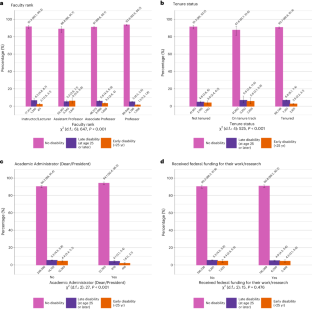Abstract
There is paucity of data examining disparities in salary and representation for disabled scientists, which is needed to advance inclusion and equity for people with disabilities in STEM. Using data from the 2019 Survey of Doctorate Recipients (United States, N = 1,148,817), we show that doctorate recipients working in Science, Technology, Engineering and Mathematics (STEM) with disabilities experienced early in life (at age <25>2: 647.2; P < 0.0001), among Deans/Presidents (χ2: 27.4; P = 0.0004) and among those with tenure (χ2: 525; P < 0.0001). These findings support a need to expand inclusion efforts, provide equal opportunities for career advancement and improve working conditions for people with disabilities in STEM.
This is a preview of subscription content, access via your institution
Access options
Access Nature and 54 other Nature Portfolio journals
Get Nature+, our best-value online-access subscription
$29.99 / 30 days
cancel any time
Subscribe to this journal
Receive 12 digital issues and online access to articles
$119.00 per year
only $9.92 per issue
Rent or buy this article
Prices vary by article type
from$1.95
to$39.95
Prices may be subject to local taxes which are calculated during checkout

Data availability
SDR 2019 data are publicly available on the NSF’s website (https://ncsesdata.nsf.gov/datadownload/), and Institutional Review Board approval was not required since data were de-identified. All analyses were conducted using R Studio v.2021.09.1. Documentation on the ‘weightit’ (v.0.14.2) and ‘cobalt’ (v.4.5.1) R packages used for propensity score computation and assessment of covariate balance can be found at https://cran.r-project.org/web/packages/cobalt/index.html and https://cran.r-project.org/web/packages/WeightIt/index.html. The code used for our analyses can be found in Supplementary Information (Methods 1).
References
-
Varadaraj, V., Deal, J. A., Campanile, J., Reed, N. S. & Swenor, B. K. National prevalence of disability and disability types among adults in the US, 2019. JAMA Netw. Open https://doi.org/10.1001/jamanetworkopen.2021.30358 (2021).
-
Women, Minorities, and Persons With Disabilities in Science and Engineering (National Science Foundation, 2021); https://ncses.nsf.gov/pubs/nsf21321
-
Swenor, B. K., Munoz, B. & Meeks, L. M. A decade of decline: grant funding for researchers with disabilities 2008 to 2018. PLoS ONE https://doi.org/10.1371/journal.pone.0228686 (2020).
-
Bernard, M. A. Advancing disability inclusion in the scientific workforce. NIH Blog https://diversity.nih.gov/blog/2021-07-21-advancing-disability-inclusion-scientific-workforce (2021).
-
Cech, E. A. The intersectional privilege of white able-bodied heterosexual men in STEM. Sci. Adv. 8, 24 (2022).
-
Freund, K. M. et al. Inequities in academic compensation by gender: a follow-up to the national faculty survey cohort study. Acad. Med. https://doi.org/10.1097/ACM.0000000000001250 (2016).
-
Survey of Doctorate Recipients, 2019 (National Science Foundation, 2021); https://ncses.nsf.gov/pubs/nsf21320
-
Berghs, M., Atkin, K., Graham, H., Hatton, C. & Thomas, C. in Implications for Public Health Research of Models and Theories of Disability: A Scoping Study and Evidence Synthesis Ch. 3 (Public Health Research No. 4.8, NIHR Journals Library, 2016).
-
Dutta, A. et al. Social-cognitive career theory predictors of STEM career interests and goal persistence in minority college students with disabilities: a path analysis. J. Vocat. Rehabil. 43, 159–167 (2015).
-
Survey of Earned Doctorates 2020: Median Age and Distribution of Doctorate Recipients, by Broad Field of Study, Sex, Citizenship Status, Ethnicity, and Race (National Science Foundation, 2021); https://ncses.nsf.gov/pubs/nsf22300/data-tables
-
Austin, P. C. An introduction to propensity score methods for reducing the effects of confounding in observational studies. Multivar. Behav. Res. 46, 399–424 (2011).
-
Mann, D. R. & Wittenburg, D. C. Starting behind: wage and employment differentials between young adults with and without disabilities. J. Disabil. Policy Stud. 26, 89–99 (2015).
-
Campanile, J. et al. Accessibility and disability inclusion among top-funded US undergraduate institutions. PLoS ONE https://doi.org/10.1371/journal.pone.0277249 (2022).
-
Goodman, N.M., Morris, Z., Morris, M. & McGarity, S. The Extra Costs of Living With a Disability in the U.S.—Resetting the Policy Table (NDI, 2020); https://www.nationaldisabilityinstitute.org/reports/extra-costs-living-with-disability/
-
Hawley, C. E. et al. College graduation to employment in STEM careers: the experience of new graduates at the intersection of underrepresented racial/ethnic minority status and disability. Rehabil. Res. Policy Educ. 28, 183–199 (2014).
-
Manyibe, E. O. et al. Career development factors for minority disability and health research leaders: a key informant study. Rehabil. Res. Policy Educ. 31, 208–229 (2017).
-
Lee, A. A comparison of postsecondary science, technology, engineering, and mathematics (STEM) enrollment for students with and without disabilities. Career Dev. Transit. Except. Individ. 34, 72–82 (2011).
-
Dali, K. The right to be included: ensuring the inclusive learning and work environment for people with disabilities in academia. Inf. Learn. Sci. https://doi.org/10.1108/ILS-04-2018-0032 (2018).
-
Peterson, S. & Saia, T. Disability, intersectionality, and the experiences of doctoral students. Rehabil. Couns. Educ. J. https://doi.org/10.52017/001c.31773 (2022).
-
Rao, S. & Gartin, B. C. Attitudes of university faculty toward accommodations to students with disabilities. J. Vocat. Spec. Needs Educ. 25, 47–54 (2003).
-
Goodwin, M. E. Making the Invisible Visible: Let’s Discuss Invisible Disabilities HAPS Educator Special Conference edn, 62–73 (ERIC, 2020).
-
Macfarlane, K. A. Disability without documentation. Fordham Law Rev. https://doi.org/10.2139/ssrn.3781221 (2021).
-
Balcazar, F. E. et al. Improving the transition outcomes of low-income minority youth with disabilities. Exceptionality 20, 114–132 (2012).
-
da Silva Cardoso, E. et al. Social-cognitive predictors of STEM career interests and goal persistence in college students with disabilities from racial and ethnic minority backgrounds. Rehabil. Res. Policy Educ. 27, 271–284 (2013).
-
National Science Foundation’s Program for Persons with Disabilities (National Science Foundation, 2002); https://www.nsf.gov/pubs/2002/nsf02094/nsf02094.pdf
-
Davis, N. A. Invisible disability. Ethics 116, 153–213 (2005).
-
Hagerman, T. K. & Houtrow, A. J. Variability in prevalence estimates of disability among children in the National Survey of Children’s Health. JAMA Pediatr. 175, 307–310 (2021).
-
van Bastelaer, A., Lemaître, G. & Marianna, P. The Definition of Part-time Work for the Purpose of International Comparisons OECD Labour Market and Social Policy Occas. Pap. No. 22 (OECD Publishing, 1997).
-
Hasanah, U. Key definitions of STEM education: Literature review. Interdiscip. J. Environ. Sci. Educ. https://doi.org/10.29333/ijese/8336 (2020).
-
McCaffrey, D. F. et al. A tutorial on propensity score estimation for multiple treatments using generalized boosted models. Stat. Med. 32, 3388–3414 (2013).
-
Funk, M. J. et al. Doubly robust estimation of causal effects. Am. J. Epidemiol. 173, 761–767 (2011).
-
DuGoff, E. H., Schuler, M. & Stuart, E. A. Generalizing observational study results: applying propensity score methods to complex surveys. Health Serv. Res. 49, 284–303 (2014).
-
Age and Sex Composition in the Unites States: 2010 (US Census Bureau, 2010); https://www.census.gov/data/tables/2010/demo/age-and-sex/2010-age-sex-composition.html
Acknowledgements
We thank the National Science Foundation for their support with inquiries regarding SDR 2019 data. This research received no specific grant from any agency in the public, commercial or not-for-profit sectors.
Author information
Authors and Affiliations
Contributions
F.C., E.S. and B.K.S. conceptualized the project. F.C., E.S., V.V. and B.K.S. developed the methodology. F.C. developed software. F.C., E.S., J.D., V.V. and B.K.S. conducted formal analysis. F.C. curated data. F.C. wrote the original draft of the paper. E.S., J.D., V.V. and B.K.S. reviewed and edited the paper. F.C. and E.S. performed visualization. B.K.S. supervised the project.
Corresponding author
Ethics declarations
Competing interests
The authors declare no competing interests.
Peer review
Peer review information
Nature Human Behaviour thanks Ilhom Akobirshoev, Kristina Petersen and the other, anonymous, reviewer(s) for their contribution to the peer review of this work. Peer reviewer reports are available.
Additional information
Publisher’s note Springer Nature remains neutral with regard to jurisdictional claims in published maps and institutional affiliations.
Supplementary information
Supplementary Information
Supplementary Fig. 1–4, Tables 1 and 2, and Methods 1.
Rights and permissions
Springer Nature or its licensor (e.g. a society or other partner) holds exclusive rights to this article under a publishing agreement with the author(s) or other rightsholder(s); author self-archiving of the accepted manuscript version of this article is solely governed by the terms of such publishing agreement and applicable law.
About this article
Cite this article
Castro, F., Stuart, E., Deal, J. et al. STEM doctorate recipients with disabilities experienced early in life earn lower salaries and are underrepresented among higher academic positions.
Nat Hum Behav (2023). https://doi.org/10.1038/s41562-023-01745-z
-
Received:
-
Accepted:
-
Published:
-
DOI: https://doi.org/10.1038/s41562-023-01745-z




